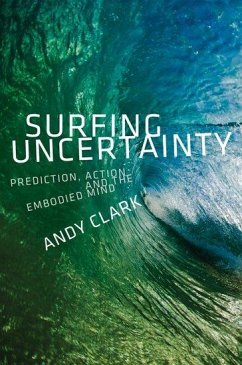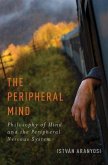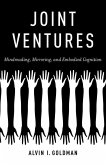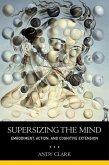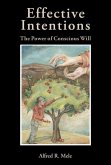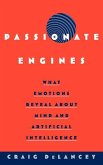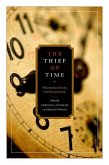- Gebundenes Buch
- Merkliste
- Auf die Merkliste
- Bewerten Bewerten
- Teilen
- Produkt teilen
- Produkterinnerung
- Produkterinnerung
Exciting new theories in neuroscience, psychology, and artificial intelligence are revealing minds like ours as predictive minds, forever trying to guess the incoming streams of sensory stimulation before they arrive.
Andere Kunden interessierten sich auch für
![Peripheral Mind Peripheral Mind]() István AranyosiPeripheral Mind134,99 €
István AranyosiPeripheral Mind134,99 €![Joint Ventures Joint Ventures]() Alvin I GoldmanJoint Ventures118,99 €
Alvin I GoldmanJoint Ventures118,99 €![Animal Spirit Doctrine and the Origins of Neurophysiology Animal Spirit Doctrine and the Origins of Neurophysiology]() C U M SmithAnimal Spirit Doctrine and the Origins of Neurophysiology231,99 €
C U M SmithAnimal Spirit Doctrine and the Origins of Neurophysiology231,99 €![Supersizing the Mind Supersizing the Mind]() Andy ClarkSupersizing the Mind147,99 €
Andy ClarkSupersizing the Mind147,99 €![Effective Intentions Effective Intentions]() Alfred R MeleEffective Intentions93,99 €
Alfred R MeleEffective Intentions93,99 €![Passionate Engines Passionate Engines]() Craig DelanceyPassionate Engines158,99 €
Craig DelanceyPassionate Engines158,99 €![Thief of Time Thief of Time]() Thief of Time147,99 €
Thief of Time147,99 €-
-
-
Exciting new theories in neuroscience, psychology, and artificial intelligence are revealing minds like ours as predictive minds, forever trying to guess the incoming streams of sensory stimulation before they arrive.
Hinweis: Dieser Artikel kann nur an eine deutsche Lieferadresse ausgeliefert werden.
Hinweis: Dieser Artikel kann nur an eine deutsche Lieferadresse ausgeliefert werden.
Produktdetails
- Produktdetails
- Verlag: Oxford University Press
- Seitenzahl: 424
- Erscheinungstermin: 3. November 2015
- Englisch
- Abmessung: 241mm x 161mm x 38mm
- Gewicht: 734g
- ISBN-13: 9780190217013
- ISBN-10: 0190217014
- Artikelnr.: 42800661
- Herstellerkennzeichnung
- Libri GmbH
- Europaallee 1
- 36244 Bad Hersfeld
- gpsr@libri.de
- Verlag: Oxford University Press
- Seitenzahl: 424
- Erscheinungstermin: 3. November 2015
- Englisch
- Abmessung: 241mm x 161mm x 38mm
- Gewicht: 734g
- ISBN-13: 9780190217013
- ISBN-10: 0190217014
- Artikelnr.: 42800661
- Herstellerkennzeichnung
- Libri GmbH
- Europaallee 1
- 36244 Bad Hersfeld
- gpsr@libri.de
Andy Clark is Professor of Logic and Metaphysics in the School of Philosophy, Psychology and Language Sciences, at Edinburgh University in Scotland. He is the author of Being There: Putting Brain, Body And World Together Again (1997), Mindware (OUP, 2nd Edition 2014), Natural-Born Cyborgs: Minds, Technologies and the Future of Human Intelligence (OUP, 2003), and Supersizing the Mind: Embodiment, Action, and Cognitive Extension (OUP, 2008). His interests include artificial intelligence, embodied cognition, robotics, and the predictive mind.
Table of Contents
Preface: Meat That Predicts
Acknowledgements
Introduction: Guessing Games
Part I: The Power of Prediction
Chapter 1: Prediction Machines
1.1 Two Ways to Sense the Coffee
1.2 Adopting the Animal's Perspective
1.3 Learning in Bootstrap Heaven
1.4 Multi-Level Learning
1.5 Decoding Digits
1.6 Dealing With Structure
1.7 Predictive Processing
1.8 Signaling the News
1.9 Predicting Natural Scenes
1.10 Binocular Rivalry
1.11 Dampening and Sharpening
1.12 Encoding, inference, and the Bayesian Brain
1.13 Getting the Gist
1.14 Predictive Processing in the Brain
1.15 Is Silence Golden?
1.16 Expecting Faces
1.17 When Prediction Misleads
1.18 Mind Turned Upside Down
Chapter Two: Adjusting The Volume (Noise, Signal, Attention)
2.1 Signal Spotting
2.2 Hearing Bing
2.3 The Delicate Dance between Top-down and Bottom-up.
2.4 Attention, Biased Competition, and Signal Enhancement
2.5 Sensory Integration and Coupling
2.6 A Taste of Action
2.7 Gaze Allocation: Doing What Comes Naturally
2.8 Circular Causation in the Perception-Attention-Action Loop
2.9 Mutual Assured Misunderstanding
2.10 Some Worries About Precision
2.11 The Unexpected Elephant
2.12 Some Pathologies of Precision
2.13 Beyond the Spotlight
Chapter 3: The Imaginarium
3.1 The Many Benefits of Controlled Hallucination
3.2 Simple Seeing
3.3 Cross-Modal and Multi-Modal effects
3.4 Meta-Modal Effects
3.5 Perceiving Omissions
3.6 Expectations and Conscious Perception
3.7 The Perceiver as Imaginer
3.8 'Brain Reading' During Imagery and Perception
3.9 Inside the Dream Factory
3.10 PIMMS and the Past
3.11 Towards Mental Time Travel
3.12 A Cognitive Package Deal
Part II: Embodying Prediction
Chapter 4: Prediction for Action
4.1 Staying Ahead of the Break
4.2 Ticklish Tales
4.3 Forward Models
4.4 Optimal Feedback Control
4.5 Action-oriented Predictive Processing
4.6 Simplifying Control
4.7 Beyond Efference Copy
4.7 Doing Without Cost Functions
4.8 Action-oriented Predictions
4.9 Predictive Robotics
4.10 Perception-Action-Understanding Machines
Chapter 5: Sculpting the Flow
5.1 Double Agents
5.2 Towards Maximal Context-Sensitivity
5.3 Hierarchy Reconsidered
5.4 Sculpting Effective Connectivity
5.5 Soft Modularity
5.6 Understanding Action
5.7 Making Mirrors
5.8 Whodunit?
5.9 Robot Futures
5.10 The Restless, Rapidly Responsive, Brain
5.11 Precision Engineering
Chapter 6: Engaging the world
6.1 Expecting the World
6.2 Controlled Hallucinations and Virtual Realities.
6.3 The Surprising Scope of Structured Probabilistic Learning
6.4 Sensing-Thinking-Acting
6. 5 Implementing Affordance Competition
6.6 Ready for Action
6.7 Hello World
6.8 'Not-Indirect' Perception
6.9 Hallucination as Uncontrolled Perception
6.10 Putting Illusions in Their Place
6.11 Safer Penetration
6.12 Who Estimates the Estimators?
6.13 Beyond Fantasy
Chapter 7: Expecting Ourselves
7.1 The Space of Human Experience
7.2 Warning Lights
7.3 The Spiral of Inference and Experience
7.4 Schizophrenia and Smooth Pursuit Eye Movements
7.5 Simulating Smooth Pursuit
7.6 Disturbing the Network (Smooth Pursuit)
7.7 Tickling Redux
7.8 Less Sense, More Action
7.9 Disturbing the Network (Sensory Attenuation)
7.10 'Psychogenic Disorders' and Placebo Effects
7.11 Disturbing the Network ('Psychogenic' Effects)
7.12 Autism, Noise, and Signal
7.13 Conscious Presence
7.14 Emotion
7.15 Fear in the Night
7.16 A Nip of the Hard Stuff
Part III: Scaffolding Prediction
Chapter 8: The Lazy Predictive Brain
8.1 Surface Tensions
8.2 Productive Laziness
8.3 Ecological Balance, and Baseball
8.4 Embodied Flow
8.5 Befriending the Bayesian Brain
8.6 Beyond the Model-Based/Model-Free Divide
8.7 Balancing Accuracy and Complexity
8.8.Back to Baseball
8.9 Extended Predictive Minds
8.10 Escape from the Darkened Room
8.11 Self-Organized Instability
8.12 Fast, Cheap, but Model-Rich Too
Chapter 9: Being Human
9.1 Putting Prediction in its Place
9.2 Reprise: Self-Organizing Around Prediction Error
9.3 Efficiency and " The Lord's Prior "
9.4 Chaos and Spontaneous Cortical Activity
9.5 Designer Environments
9.6 White Lines
9.7 Innovating for Innovation
9.8 Words as Artificial Contexts
9.9 Predicting With Others
9.10 Enacting Our Worlds
9.11 Representations: Breaking Good
9.12 Prediction in the Wild
Chapter 10: The Future of Prediction
10.1 Attractions
10.2 Problems, Puzzles, and Pitfalls
Appendix 1: Bare Bayes
Appendix 2: The Free Energy Formulation
References
Index
Preface: Meat That Predicts
Acknowledgements
Introduction: Guessing Games
Part I: The Power of Prediction
Chapter 1: Prediction Machines
1.1 Two Ways to Sense the Coffee
1.2 Adopting the Animal's Perspective
1.3 Learning in Bootstrap Heaven
1.4 Multi-Level Learning
1.5 Decoding Digits
1.6 Dealing With Structure
1.7 Predictive Processing
1.8 Signaling the News
1.9 Predicting Natural Scenes
1.10 Binocular Rivalry
1.11 Dampening and Sharpening
1.12 Encoding, inference, and the Bayesian Brain
1.13 Getting the Gist
1.14 Predictive Processing in the Brain
1.15 Is Silence Golden?
1.16 Expecting Faces
1.17 When Prediction Misleads
1.18 Mind Turned Upside Down
Chapter Two: Adjusting The Volume (Noise, Signal, Attention)
2.1 Signal Spotting
2.2 Hearing Bing
2.3 The Delicate Dance between Top-down and Bottom-up.
2.4 Attention, Biased Competition, and Signal Enhancement
2.5 Sensory Integration and Coupling
2.6 A Taste of Action
2.7 Gaze Allocation: Doing What Comes Naturally
2.8 Circular Causation in the Perception-Attention-Action Loop
2.9 Mutual Assured Misunderstanding
2.10 Some Worries About Precision
2.11 The Unexpected Elephant
2.12 Some Pathologies of Precision
2.13 Beyond the Spotlight
Chapter 3: The Imaginarium
3.1 The Many Benefits of Controlled Hallucination
3.2 Simple Seeing
3.3 Cross-Modal and Multi-Modal effects
3.4 Meta-Modal Effects
3.5 Perceiving Omissions
3.6 Expectations and Conscious Perception
3.7 The Perceiver as Imaginer
3.8 'Brain Reading' During Imagery and Perception
3.9 Inside the Dream Factory
3.10 PIMMS and the Past
3.11 Towards Mental Time Travel
3.12 A Cognitive Package Deal
Part II: Embodying Prediction
Chapter 4: Prediction for Action
4.1 Staying Ahead of the Break
4.2 Ticklish Tales
4.3 Forward Models
4.4 Optimal Feedback Control
4.5 Action-oriented Predictive Processing
4.6 Simplifying Control
4.7 Beyond Efference Copy
4.7 Doing Without Cost Functions
4.8 Action-oriented Predictions
4.9 Predictive Robotics
4.10 Perception-Action-Understanding Machines
Chapter 5: Sculpting the Flow
5.1 Double Agents
5.2 Towards Maximal Context-Sensitivity
5.3 Hierarchy Reconsidered
5.4 Sculpting Effective Connectivity
5.5 Soft Modularity
5.6 Understanding Action
5.7 Making Mirrors
5.8 Whodunit?
5.9 Robot Futures
5.10 The Restless, Rapidly Responsive, Brain
5.11 Precision Engineering
Chapter 6: Engaging the world
6.1 Expecting the World
6.2 Controlled Hallucinations and Virtual Realities.
6.3 The Surprising Scope of Structured Probabilistic Learning
6.4 Sensing-Thinking-Acting
6. 5 Implementing Affordance Competition
6.6 Ready for Action
6.7 Hello World
6.8 'Not-Indirect' Perception
6.9 Hallucination as Uncontrolled Perception
6.10 Putting Illusions in Their Place
6.11 Safer Penetration
6.12 Who Estimates the Estimators?
6.13 Beyond Fantasy
Chapter 7: Expecting Ourselves
7.1 The Space of Human Experience
7.2 Warning Lights
7.3 The Spiral of Inference and Experience
7.4 Schizophrenia and Smooth Pursuit Eye Movements
7.5 Simulating Smooth Pursuit
7.6 Disturbing the Network (Smooth Pursuit)
7.7 Tickling Redux
7.8 Less Sense, More Action
7.9 Disturbing the Network (Sensory Attenuation)
7.10 'Psychogenic Disorders' and Placebo Effects
7.11 Disturbing the Network ('Psychogenic' Effects)
7.12 Autism, Noise, and Signal
7.13 Conscious Presence
7.14 Emotion
7.15 Fear in the Night
7.16 A Nip of the Hard Stuff
Part III: Scaffolding Prediction
Chapter 8: The Lazy Predictive Brain
8.1 Surface Tensions
8.2 Productive Laziness
8.3 Ecological Balance, and Baseball
8.4 Embodied Flow
8.5 Befriending the Bayesian Brain
8.6 Beyond the Model-Based/Model-Free Divide
8.7 Balancing Accuracy and Complexity
8.8.Back to Baseball
8.9 Extended Predictive Minds
8.10 Escape from the Darkened Room
8.11 Self-Organized Instability
8.12 Fast, Cheap, but Model-Rich Too
Chapter 9: Being Human
9.1 Putting Prediction in its Place
9.2 Reprise: Self-Organizing Around Prediction Error
9.3 Efficiency and " The Lord's Prior "
9.4 Chaos and Spontaneous Cortical Activity
9.5 Designer Environments
9.6 White Lines
9.7 Innovating for Innovation
9.8 Words as Artificial Contexts
9.9 Predicting With Others
9.10 Enacting Our Worlds
9.11 Representations: Breaking Good
9.12 Prediction in the Wild
Chapter 10: The Future of Prediction
10.1 Attractions
10.2 Problems, Puzzles, and Pitfalls
Appendix 1: Bare Bayes
Appendix 2: The Free Energy Formulation
References
Index
Table of Contents
Preface: Meat That Predicts
Acknowledgements
Introduction: Guessing Games
Part I: The Power of Prediction
Chapter 1: Prediction Machines
1.1 Two Ways to Sense the Coffee
1.2 Adopting the Animal's Perspective
1.3 Learning in Bootstrap Heaven
1.4 Multi-Level Learning
1.5 Decoding Digits
1.6 Dealing With Structure
1.7 Predictive Processing
1.8 Signaling the News
1.9 Predicting Natural Scenes
1.10 Binocular Rivalry
1.11 Dampening and Sharpening
1.12 Encoding, inference, and the Bayesian Brain
1.13 Getting the Gist
1.14 Predictive Processing in the Brain
1.15 Is Silence Golden?
1.16 Expecting Faces
1.17 When Prediction Misleads
1.18 Mind Turned Upside Down
Chapter Two: Adjusting The Volume (Noise, Signal, Attention)
2.1 Signal Spotting
2.2 Hearing Bing
2.3 The Delicate Dance between Top-down and Bottom-up.
2.4 Attention, Biased Competition, and Signal Enhancement
2.5 Sensory Integration and Coupling
2.6 A Taste of Action
2.7 Gaze Allocation: Doing What Comes Naturally
2.8 Circular Causation in the Perception-Attention-Action Loop
2.9 Mutual Assured Misunderstanding
2.10 Some Worries About Precision
2.11 The Unexpected Elephant
2.12 Some Pathologies of Precision
2.13 Beyond the Spotlight
Chapter 3: The Imaginarium
3.1 The Many Benefits of Controlled Hallucination
3.2 Simple Seeing
3.3 Cross-Modal and Multi-Modal effects
3.4 Meta-Modal Effects
3.5 Perceiving Omissions
3.6 Expectations and Conscious Perception
3.7 The Perceiver as Imaginer
3.8 'Brain Reading' During Imagery and Perception
3.9 Inside the Dream Factory
3.10 PIMMS and the Past
3.11 Towards Mental Time Travel
3.12 A Cognitive Package Deal
Part II: Embodying Prediction
Chapter 4: Prediction for Action
4.1 Staying Ahead of the Break
4.2 Ticklish Tales
4.3 Forward Models
4.4 Optimal Feedback Control
4.5 Action-oriented Predictive Processing
4.6 Simplifying Control
4.7 Beyond Efference Copy
4.7 Doing Without Cost Functions
4.8 Action-oriented Predictions
4.9 Predictive Robotics
4.10 Perception-Action-Understanding Machines
Chapter 5: Sculpting the Flow
5.1 Double Agents
5.2 Towards Maximal Context-Sensitivity
5.3 Hierarchy Reconsidered
5.4 Sculpting Effective Connectivity
5.5 Soft Modularity
5.6 Understanding Action
5.7 Making Mirrors
5.8 Whodunit?
5.9 Robot Futures
5.10 The Restless, Rapidly Responsive, Brain
5.11 Precision Engineering
Chapter 6: Engaging the world
6.1 Expecting the World
6.2 Controlled Hallucinations and Virtual Realities.
6.3 The Surprising Scope of Structured Probabilistic Learning
6.4 Sensing-Thinking-Acting
6. 5 Implementing Affordance Competition
6.6 Ready for Action
6.7 Hello World
6.8 'Not-Indirect' Perception
6.9 Hallucination as Uncontrolled Perception
6.10 Putting Illusions in Their Place
6.11 Safer Penetration
6.12 Who Estimates the Estimators?
6.13 Beyond Fantasy
Chapter 7: Expecting Ourselves
7.1 The Space of Human Experience
7.2 Warning Lights
7.3 The Spiral of Inference and Experience
7.4 Schizophrenia and Smooth Pursuit Eye Movements
7.5 Simulating Smooth Pursuit
7.6 Disturbing the Network (Smooth Pursuit)
7.7 Tickling Redux
7.8 Less Sense, More Action
7.9 Disturbing the Network (Sensory Attenuation)
7.10 'Psychogenic Disorders' and Placebo Effects
7.11 Disturbing the Network ('Psychogenic' Effects)
7.12 Autism, Noise, and Signal
7.13 Conscious Presence
7.14 Emotion
7.15 Fear in the Night
7.16 A Nip of the Hard Stuff
Part III: Scaffolding Prediction
Chapter 8: The Lazy Predictive Brain
8.1 Surface Tensions
8.2 Productive Laziness
8.3 Ecological Balance, and Baseball
8.4 Embodied Flow
8.5 Befriending the Bayesian Brain
8.6 Beyond the Model-Based/Model-Free Divide
8.7 Balancing Accuracy and Complexity
8.8.Back to Baseball
8.9 Extended Predictive Minds
8.10 Escape from the Darkened Room
8.11 Self-Organized Instability
8.12 Fast, Cheap, but Model-Rich Too
Chapter 9: Being Human
9.1 Putting Prediction in its Place
9.2 Reprise: Self-Organizing Around Prediction Error
9.3 Efficiency and " The Lord's Prior "
9.4 Chaos and Spontaneous Cortical Activity
9.5 Designer Environments
9.6 White Lines
9.7 Innovating for Innovation
9.8 Words as Artificial Contexts
9.9 Predicting With Others
9.10 Enacting Our Worlds
9.11 Representations: Breaking Good
9.12 Prediction in the Wild
Chapter 10: The Future of Prediction
10.1 Attractions
10.2 Problems, Puzzles, and Pitfalls
Appendix 1: Bare Bayes
Appendix 2: The Free Energy Formulation
References
Index
Preface: Meat That Predicts
Acknowledgements
Introduction: Guessing Games
Part I: The Power of Prediction
Chapter 1: Prediction Machines
1.1 Two Ways to Sense the Coffee
1.2 Adopting the Animal's Perspective
1.3 Learning in Bootstrap Heaven
1.4 Multi-Level Learning
1.5 Decoding Digits
1.6 Dealing With Structure
1.7 Predictive Processing
1.8 Signaling the News
1.9 Predicting Natural Scenes
1.10 Binocular Rivalry
1.11 Dampening and Sharpening
1.12 Encoding, inference, and the Bayesian Brain
1.13 Getting the Gist
1.14 Predictive Processing in the Brain
1.15 Is Silence Golden?
1.16 Expecting Faces
1.17 When Prediction Misleads
1.18 Mind Turned Upside Down
Chapter Two: Adjusting The Volume (Noise, Signal, Attention)
2.1 Signal Spotting
2.2 Hearing Bing
2.3 The Delicate Dance between Top-down and Bottom-up.
2.4 Attention, Biased Competition, and Signal Enhancement
2.5 Sensory Integration and Coupling
2.6 A Taste of Action
2.7 Gaze Allocation: Doing What Comes Naturally
2.8 Circular Causation in the Perception-Attention-Action Loop
2.9 Mutual Assured Misunderstanding
2.10 Some Worries About Precision
2.11 The Unexpected Elephant
2.12 Some Pathologies of Precision
2.13 Beyond the Spotlight
Chapter 3: The Imaginarium
3.1 The Many Benefits of Controlled Hallucination
3.2 Simple Seeing
3.3 Cross-Modal and Multi-Modal effects
3.4 Meta-Modal Effects
3.5 Perceiving Omissions
3.6 Expectations and Conscious Perception
3.7 The Perceiver as Imaginer
3.8 'Brain Reading' During Imagery and Perception
3.9 Inside the Dream Factory
3.10 PIMMS and the Past
3.11 Towards Mental Time Travel
3.12 A Cognitive Package Deal
Part II: Embodying Prediction
Chapter 4: Prediction for Action
4.1 Staying Ahead of the Break
4.2 Ticklish Tales
4.3 Forward Models
4.4 Optimal Feedback Control
4.5 Action-oriented Predictive Processing
4.6 Simplifying Control
4.7 Beyond Efference Copy
4.7 Doing Without Cost Functions
4.8 Action-oriented Predictions
4.9 Predictive Robotics
4.10 Perception-Action-Understanding Machines
Chapter 5: Sculpting the Flow
5.1 Double Agents
5.2 Towards Maximal Context-Sensitivity
5.3 Hierarchy Reconsidered
5.4 Sculpting Effective Connectivity
5.5 Soft Modularity
5.6 Understanding Action
5.7 Making Mirrors
5.8 Whodunit?
5.9 Robot Futures
5.10 The Restless, Rapidly Responsive, Brain
5.11 Precision Engineering
Chapter 6: Engaging the world
6.1 Expecting the World
6.2 Controlled Hallucinations and Virtual Realities.
6.3 The Surprising Scope of Structured Probabilistic Learning
6.4 Sensing-Thinking-Acting
6. 5 Implementing Affordance Competition
6.6 Ready for Action
6.7 Hello World
6.8 'Not-Indirect' Perception
6.9 Hallucination as Uncontrolled Perception
6.10 Putting Illusions in Their Place
6.11 Safer Penetration
6.12 Who Estimates the Estimators?
6.13 Beyond Fantasy
Chapter 7: Expecting Ourselves
7.1 The Space of Human Experience
7.2 Warning Lights
7.3 The Spiral of Inference and Experience
7.4 Schizophrenia and Smooth Pursuit Eye Movements
7.5 Simulating Smooth Pursuit
7.6 Disturbing the Network (Smooth Pursuit)
7.7 Tickling Redux
7.8 Less Sense, More Action
7.9 Disturbing the Network (Sensory Attenuation)
7.10 'Psychogenic Disorders' and Placebo Effects
7.11 Disturbing the Network ('Psychogenic' Effects)
7.12 Autism, Noise, and Signal
7.13 Conscious Presence
7.14 Emotion
7.15 Fear in the Night
7.16 A Nip of the Hard Stuff
Part III: Scaffolding Prediction
Chapter 8: The Lazy Predictive Brain
8.1 Surface Tensions
8.2 Productive Laziness
8.3 Ecological Balance, and Baseball
8.4 Embodied Flow
8.5 Befriending the Bayesian Brain
8.6 Beyond the Model-Based/Model-Free Divide
8.7 Balancing Accuracy and Complexity
8.8.Back to Baseball
8.9 Extended Predictive Minds
8.10 Escape from the Darkened Room
8.11 Self-Organized Instability
8.12 Fast, Cheap, but Model-Rich Too
Chapter 9: Being Human
9.1 Putting Prediction in its Place
9.2 Reprise: Self-Organizing Around Prediction Error
9.3 Efficiency and " The Lord's Prior "
9.4 Chaos and Spontaneous Cortical Activity
9.5 Designer Environments
9.6 White Lines
9.7 Innovating for Innovation
9.8 Words as Artificial Contexts
9.9 Predicting With Others
9.10 Enacting Our Worlds
9.11 Representations: Breaking Good
9.12 Prediction in the Wild
Chapter 10: The Future of Prediction
10.1 Attractions
10.2 Problems, Puzzles, and Pitfalls
Appendix 1: Bare Bayes
Appendix 2: The Free Energy Formulation
References
Index

